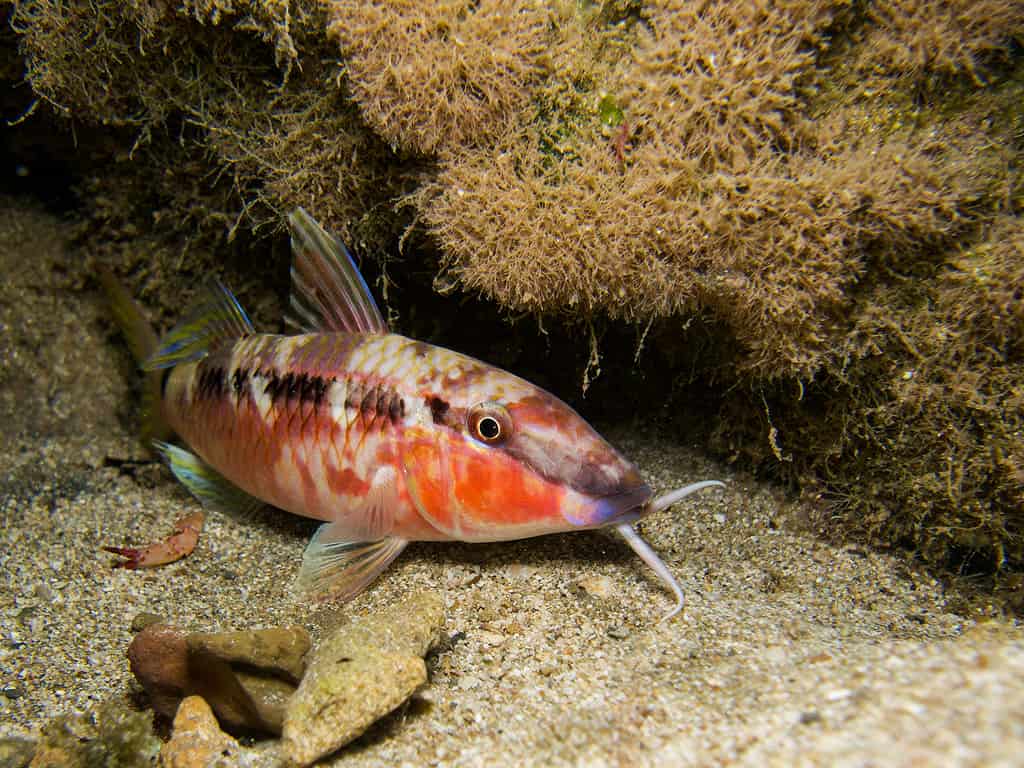Found in tropical regions, goatfish thrive in shallow ocean waters with coral reefs. As they spend their time nosing around the sand or reefs for invertebrates to eat, their unique barbels help them sense food. But this isn’t the only unique feature of the goatfish. Discover the lifecycle and habitat of the goatfish and why some places can’t get enough of this saltwater red mullet.
4 Amazing Goatfish Facts

When the goatfish is not using its barbels to search for food, the barbels are held in a groove on the throat.
©Sakis Lazarides/iStock via Getty Images
- Goatfish possess two sensory barbels that hang from their chins, giving goatfish the appearance of having a goatee, thus the name. Goatfish use their barbels to probe the sand or reefs for prey.
- Goatfish have diverse habits, depending on the species. Some feed during the day and are solitary fish. Others feed at night and congregate in large schools during the day.
- Most goatfish species are brightly colored. All species may change their coloring to blend in with their environment to hide from predators.
- For ancient Romans, eating goatfish was an aesthetic experience. The most popular species of goatfish, Mullus barbatus, lived in the Mediterranean and was a huge part of the fishery economy.
Goatfish Scientific Classification
Belonging to the family of Mullidae, goatfish are perciform fish, a sub-order of ray-finned fish. Also known as red mullets, goatfish fall into six genera and at least 65 species.
Here is the scientific classification of goatfish:
- Domain: Eukaryota
- Kingdom: Animalia
- Phylum: Chordata
- Class: Actinopterygii
- Order: Perciformes
- Superfamily: Percoidea
- Family: Mullidae
Habitat
Dwelling in tropical and subtropical parts of the Atlantic, Indian, and Pacific Oceans, goatfish keep to shallow water with sandy bottoms and near coral reefs. Typically, these fish don’t roam any deeper than 360 feet. Currently, their conservation status is of Least Concern, as goatfish populations are quite robust.
Appearance

The majority of goatfish are brightly colored, though not every species is.
©Nikolay Dimitrov/iStock via Getty Images
Goatfish have elongated bodies with two widely separated dorsal fins and forked tails. The first dorsal has six to eight spines, while the second dorsal has one spine with about eight to nine soft rays. They also have 24 vertebrae.
Goatfish range from nine to 24 inches long, though most grow to be around a foot long. Generally, goatfish grow to be one to two pounds in size.
While the majority of goatfish species are brightly colored, not all of them are. However, every species of goatfish can change their coloring to blend in with their surroundings to hide from predators. In fact, the mimic goatfish, Mulloidichthys mimicus, can mirror the appearance of the blue-striped snapper. That is why mimic goatfish often hang around schools of blue-striped snappers.
The two chin barbels on the goatfish give it the appearance of having a goatee. The chemosensory organs within the barbels help the goatfish locate food in murky or low-light conditions. The barbels are an outgrowth of the taste system, allowing the goatfish to sense enzymes in the water. Depending on the enzymes, this may lead the fish to a food source or warn the goatfish of possible predators approaching.
A study was done on the freckled goatfish, Upeneus tragula, to see if food availability affected the size of the barbels. Scientists deprived a group of freckled goatfish of food for two days in the laboratory. They found that this group of goatfish grew larger barbels than those fed consistently. The larger barbels helped the freckled goatfish capture prey and compete against other fish for food. However, the drawback to these larger barbels was that the freckled goatfish experienced a decreased growth rate.
Diet
Goatfish are carnivores who feed upon bottom-dwelling invertebrates such as worms, crustaceans, and small mollusks. Some species of goatfish even feed on small fish. To find food, the goatfish roots around the sand, using its chin barbels to sense prey. Then, the prey is swallowed up, with the sand expelled from the gill cover. Some species of goatfish are active at night and keep to the reefs during the day. Other species feed during the day, hovering in schools during inactive times.
Predators

Goatfishes are economically important in many coastal areas and are popular bait fish.
©Gema Alvarez Fernandez/Shutterstock.com
Large reef predators such as sharks, tuna, mahi-mahi, and jacks prey upon goatfish. These fish are also popular to use as bait and are favored dishes in Asia and Hawaii.
Reproduction and Lifecycle
Goatfish are pelagic spawners, meaning water currents disperse their buoyant eggs. The eggs float along the currents until they hatch. Then, the larvae grow and develop barbels over four to eight weeks. Once the barbels are formed, goatfish start bottom-feeding, or some species stay and feed on plankton until they reach maturity at one to two years.
Cultural Importance

Ancient Romans enjoyed seeing the color change of the goatfish, which is why it was most often served alive.
©photooiasson/iStock via Getty Images
Goatfish are extremely popular in Hawaii. The manybar goatfish is featured in a Hawaiian song for its delicious taste, known in Hawaii as moano-nui-ka-lehua or “great moano of the lehua.” Moano is Hawaiian for “pale red color.”
Also, the whitesaddle goatfish is known in Hawaiian as kūmū, which means foundation, source, or teacher. When priests presented offerings to the gods for events like canoe launches or hula ceremonies, the kūmū was offered. The kūmū was also a prized delicacy that Hawaiian people would broil, cook in ti leaves, or cover in salt for three days before roasting.
Goatfish were also important to the fishery in ancient Rome. The red mullet, Mullus barbatus, and the striped red mullet, Mullus surmuletus, were especially popular and expensive species to the Romans. These types of goatfish were valued for the aesthetic dining experience. Because of their mimicry ability, the goatfish rapidly change color, even during death. Thus, the Romans served the fish live so guests could experience the color shifts in real time as the fish died. Then, the fish was consumed.
The photo featured at the top of this post is © Sakis Lazarides/iStock via Getty Images
Thank you for reading! Have some feedback for us? Contact the AZ Animals editorial team.






